
Art Project – Postcards from Hell – Mail art 2017-2018
Art must embrace ambiguity. Why is this, you might ask? Well, the best art brings you, the audience, into the creative process. Ambiguity gives you room to fill in the blanks and finish the work. Indeed, the best art is never complete when the painter puts down his brush or the writer her pen.
While collaboration is often preferred, in a real sense there is always a collaborative construction taking place and collaboration can bring the third mind into the creative process. Artist, audience and work evoke the mystical. There are a variety of mythical symbols that are shared through the unconscious – something that Jung would call the archetypes.
One way to allow the ambiguous to thrive is when the craftsperson lets go and allows apparent “random events” to shape the work without the conscious will of the artist interfering with the process.
Now for an overview of the project called Postcards from Hell.
Number 1: Postcards From Hell and Mail Art revival
Gnostics see the world as upside down or as it is formalized: the Gnostic’s world has been created by the dark force personified as the devil. Simply put, this world is Hell. From a Gnostic perspective, one can not begin to comprehend what’s going on without recognizing this core truth.
Today, many of the formerly affluent American middle class can reach similar realizations and see that throughout history what we have long called “reality” is actually something that has been constructed by the hands of man and not by God or some other benign power.
Those with the prestige and the very real power of wealth have long wished to satisfy their own insatiable desires and this, in turn, has only worked to heighten their thirst for power. The sort of personal, self-gratifying Epicurean utopia they wished to build for themselves has perversely only fed their misery and their isolation. This was no heaven for the rest of us either, but a living hell of neglect, intolerance, oppression, distortion and violence, exploitation and humiliation. As the ever expanding abyss of death and extinction widen, all are to find a miserable and unsatisfying end…every one of us.
This first postcard in the series finds its roots in the late 1970s industrial music scene that emerged alongside, or really just below, the “underground” punk rock movement. Just as abstraction destroyed the plastic arts, so punk was to shatter rock and even more deeply, as noise, industrial sounds came to shatter all musical form.
With roots in the Italian Futurist movement industrial music likely drew more from Dadaism and Surrealism than from preceding musical traditions. This tends to make more sense when you consider what it is we are dealing with here.
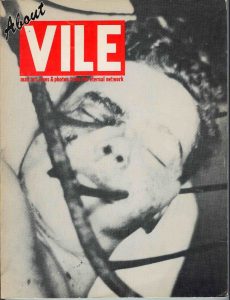 Like punk, industrial music was open to all comers as it embraced primitivism and the creativity of the do-it-yourself. Anyone could make noise just like anyone could bang a guitar and call it punk. All it really took was a tape recorder and some imagination.
Like punk, industrial music was open to all comers as it embraced primitivism and the creativity of the do-it-yourself. Anyone could make noise just like anyone could bang a guitar and call it punk. All it really took was a tape recorder and some imagination.
The musicians and the work could flourish. Networks were established and the scene in the late 1970s gave rise to trading cassette tapes, do-it-yourself magazines, theories, broadsides, poetry and other imaginings often through what was called Mail Art. This established an informal exchange between artists and patrons and allowed otherwise obscure work to be seen and heard.
Some of the magazines became important on a wider scale such as Anna Banana’s Vile magazine:
So this first postcard went to my baby brother.
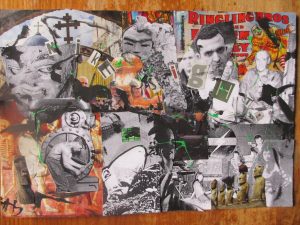
It is called Nikesight. This was a puzzle (or the work as a puzzle piece) and an anagram for the Reveille website url: theking.is (an Icelandic domain). A number of industrial artists are within the piece. In the lower right corner is Cosey Fanni Tutti of Throbbing Gristle along with the whole band over her right shoulder (minus Chris Carter who has been cut out). Above this is an image of front-man Genesis P-Orridge with William S. Burroughs. Along with the original innovator Brion Gysin, of course, Burroughs used the cut-up method of writing that, like abstract expressionism, basically destroyed the literature as a form – most critically in his masterpiece Naked Lunch. Burroughs would become an iconic figure and mentor to early industrial musicians. The forth member of Throbbing Gristle, Sleazy Christopherson, partly obscures Genesis and is by the letter “g”. Sleazy went on to form Psychic TV with Genesis and later Coil with his partner John Balance. The striking “cone-headed” freak in the lower center part of this postcard is the cover of Clock DVA’s debut album White Souls in Black Suits.
Now you should sample some of this music, especially if you aren’t familiar with it.
Throbbing Gristle – “Hamburger Lady” preferably a good live version, but if unavailable the studio version will work. Originally on studio album D.o.A: The Third and Final Report of Throbbing Gristle (1978).
SPK – “Suture Obsession” from their debut album Information Overload Unit (1981).
Nurse with Wound – Sample portions of Spiral Insana album (1986).
Coil – “Circle of Mania” from Horse Rotorvator (1986).
Like any complicated work of music, these must be heard a few times to be fully appreciated and feel free to incorporate your favorite mind enhancement herbs, fungi or cacti.
Postcard #2: Exploring Dystopian Themes
While the initial piece was inspired by a reading of S. Alexander Reed’s Assimilate, this piece was inspired by Pulitzer Prize winning historian Barbara Tuchman’s A Distant Mirror: The Calamitous 14th Century and its descriptions of the Black Death.
A most striking aspect of our dystopian times today is the number of apparent “existential crises” we are experiencing including the real threat of contagion. We can bring this upon ourselves through the weaponization of disease and biological substances, but we are also living with reduced stockpiles of vaccines in an era when big Pharma is pursuing more profitable miracle cures and treatments for popular diseases.
As an unknown artist, one of the struggles is finding an audience. Mail Art effectively forces consumption of the work, so, like the Lost and Found project, it gets the work in front of an audience. This particular one went to a long-time friend and trusted supporter and is called Mister Tummy Ache Comes to Town:
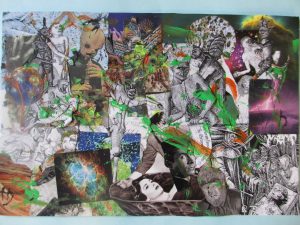
Postcard #3: Regurgitation
Art can perform a cathartic function. Artists are visionaries. In our post-modern culture, artists serve the purpose of society’s prophets, agitators and sages. What they see, though, isn’t always beautiful especially as they look into this world we’ve hobbled together from our fractured selves disconnected, as we are, from what is imperative and truly real and truly beautiful.
Art is highly complicated. It is necessarily flawed as is everything we make with our hands. Ultimately, art contains ugliness and its beauty can only be a pale reflection of the truthful beauty of our natural earth and the universe. At least partly, art must draw from the dark side since this is the source of both destructive and creative energies.
Consider that the construction of this world is destructive of the earth and in resurrecting the earth, we must dismantle this world.
You may question this, but this contradiction of forces feeds my work and contributes to its ambiguity.
This one was sent to the oldest son of the artist’s baby brother and is called American Dreemin’:
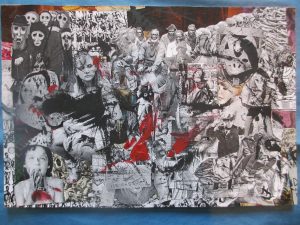
This is a complaint about poverty that has become more and more abject and about the everyday banality of evil. The theme and look and feel would be carried through with other pieces in the series. The photographs of the pieces, like the one included here, only give a sense of the actual piece.
This particular postcard had deep levels of images – some of which appear on the final piece and others remain buried within. This gave the final piece a vibrant complexity. It’s very dark with almost exclusive use of black and white images. The sign at the bottom center says, “I used to be your neighbor”. I guess that sums up the piece for me.
Again, and importantly, these cards are puzzle pieces. There ends up being reoccurring themes – primarily death, misery and injustice – and this one certainly puts these on display.
- Duality and Our Broken Existence
The project kept going. Next was a card for a much loved close-by cousin. Eventually, the work became a diptych, so her artistic husband was included.
This was a “Me-Too” piece and at its core it speaks about our broken halves. The piece is based on the belief that we – men and women – were formerly united in spirit and part of our actualization as humans is the process of uniting these fractured halves to reform our whole being. Humans were meant to be a balance of the masculine and the feminine, but when one overpowers the other well…things get messy.
So in these diptychs titled Boss Coil we see the reoccurring themes of violence, objectification, oppression, dismemberment, exploitation and how our world – the patriarchy – is a reflection of our Humpty-Dumpty selves.
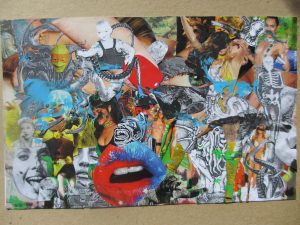
Boss Coil – Left Diptych to the husband (the masculine half).
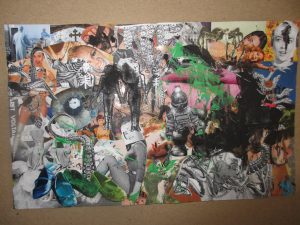
Boss Coil – Right Diptych to the wife (the feminine half). You might be able to notice how these two pieces can be fit together like two pieces of a puzzle (fitting but not really “fitting” wholly together).
Postcard 5: Connecting in Madness
It was during the production of all this work in the Trumpian era, that a member of our house received in the mail a painting of a dragon from a niece who was approaching her teen years. So there was a connection through the third mind that obviously compelled the artist to direct the next piece to the artistic niece. No question, we were working from the same source.
The card was already in motion and was all about madness and murder. This is what we now teach our children from the get-go: yes, Monsters are Real.
Horror and science fiction, particularly in film, has inspired me from my earliest childhood. This connection to the genre is most especially found in the complex layers of meaning and metaphor found in Mary Shelley’s Frankenstein.
It was apparent that there was a shared appreciation with my young niece who had an ancient soul with the monsters that emerge from the darkness.
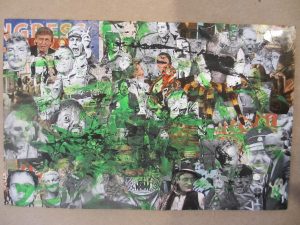
Certainly, the piece ended up being a bit disturbing. Like the other pieces, the juxtaposition of the various images from the collages is more or less “random” and attempts to tap into this thing we are calling the “third mind”. In the lower right corner is our former (current at the time) attorney general enjoying a goblet of vino next to the smirking visage of Heinrich Himmler. Something eerie connects the two visages.
This detail of the upper central portion of the piece gives an idea of the variety of subjects one may miss on the full depiction:
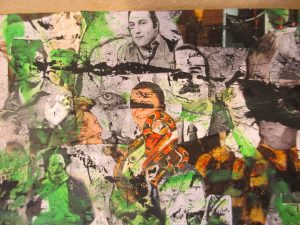
So notably we see David “Son of Sam” Berkowitz and a green-tinted Leatherface from Texas Chainsaw Massacre. The detail helps you see Richard “Night Stalker” Ramirez through some of the green and black paint holding up his left hand to display the pentagram he has on his palm. So nice of him to let us know who he is. Of course, the secret to these monsters’ success is looking like you and I. That’s G. Gordon Liddy, the Gipper (or is it?) and Nancy, and the haunted eyes at the bottom and next to Karloff’s Mummy belong to our time’s mass shooter Devin Patrick Kelley who killed dozens at the First Baptist Church in Sutherland Springs Texas not quite a year ago.
The personalized message included the warning that the piece was “…about scary ones, phony ones and the worst ones, but it’s not about good monsters.” So even though one might see a good monster or two in the piece, the work is definitely not about them. Audience participation too – so you decide in the end who is a good monster and who is a bad monster or phony monster and…well…then there are ones you may not be entirely sure about. See…monsters like ambiguity too!
Postcard #6: More Man-Made Monsters
Sometimes the intended recipient of the card is known even before the start of the collage and at other times this becomes known while I am working on the piece. The piece itself always ends up taking a life of its own whether the recipient is known or not. The images being collected can help guide the theme of the piece or the theme can help with the image selections. By the end of the assemblage there is always something being sought after.
Somewhere along the line with this one, I decided to send one to a good friend and artist in New Mexico. So this one had to be about technology and humanity’s search for redemption in the creation of the perfect being – a being we’ve constructed with our own hands.
Art is artifice and constructed by the imperfect hands of man, so what should we expect from that one might ask? Our fabrications are either pale reflections of true beauty or meant to show the ugliness of imaginings made manifest. Like Shelley’s creature, the man-made man or man-made monster, if you will, is part of our pursuit for redemption currently trending in the transhumanist quest for eternal life and possibly even some event of singularity.
So it’s another one of these existential crises. Global capitalism demands that commerce pushes technology to the fore without forethought or consideration of its effects on our civilization, our species or upon the planet. AI is like throwing a lighted match into a powder keg.
Call this one IT:
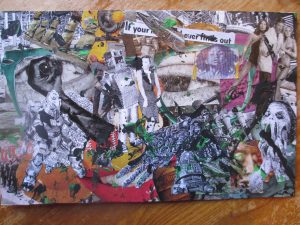
This card was a bit different in that certain elements were manipulated consciously to produce a skeletal framework for the piece. This is mainly evident in the face within the machine. An item of interest might be the eyes of this face. They are backwards and are indeed the eyes of the beast – our master.
Number 7: The last is always best
The final postcard titled Post-Modern Return to the Modern Aesthetic is here:
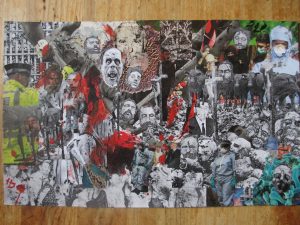
This card had a theme developed shortly after completing IT. A friend in Alabama had sent me a short note in the mail with some concern about my psychological state, so it was easy enough to choose who to send this to.
Disturbingly, many of the discussions I have with generally affluent and politically conservative white Americans (this likely classifies many of the people I know), bring to light their view of what is wrong with our world today. Inevitably, it is demographics as not only a symptom of global social problems, but for literally every conservative I have this conversation with it’s the source of the problems. That’s right, it’s not capitalism or greed, it’s not the disparity of wealth or our violent cultures or even imperialism. It’s not environmental, it’s not nuclear proliferation or the animal agricultural industry or any of that. It is simply global overpopulation. They all agree on this and point to this as the summation of what’s going wrong in the world today.
OK, so then they’ve nailed down the source of all the world’s darkest and most profound problems. What about solutions? Well, that’s where things get a bit disturbing.
Of course, I’ll always discuss the only real solution I’ve ever seen that is worthwhile – to elevate the third world to enough affluence that populations are brought under control – you know educate, provide access to affordable health care, improved childhood mortality, etc. You see it in developed nations – birth rates will actually go into negatives.
Not a solution to these conservatives. No surprise there since their values really begin and end with their own personal well-being. Their solution is well…it’s been called the Final Solution. It’s genocidal. “Let them die”. Starve them, deny them access to healthcare and basic needs…a pox on them or a war or some other horrible and evil path.
So genocide – along with slavery a guiding principle of America’s founding – is really their “unspoken” answer. The severed heads, the crucified children, the rows upon rows of emancipated corpses laid like firewood…this is the modern aesthetic. The modern aesthetic of evil and like so much we once believed purged from our civilized society has never actually gone away – thus the return of the modern aesthetic in our post-modern times.
Here is a shot of the piece before the final trim and paint was applied:
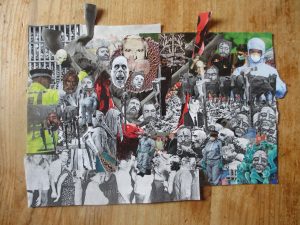
In the lower left corner you can pretty clearly see the bottom half of a classic lynching picture from the south (I think Alabama) with all the white people and the festive attitude they bring to the event. One man is smugly pointing to the hanged black man (completely covered in the collage). There is a repeating pattern of crucified young girls from the Armenian genocide. There are the repeating themes from other cards like masks, monsters, disease and addiction, and poverty as it is all interrelated to this topic.
The art, and certainly these postcards, relies on the third mind and a sort of “random” juxtaposition of lines, colors, figures, etc. to provide another picture within the picture. The idea is to produce something hallucinogenic and encourage an altered sense of reality so that the hidden pictures become a product of the individual mind of the viewer and his/her imagination and the “chance” serendipity or synchronicity, if you will, that arises when the third mind is invoked.
Each card relies on the viewers’ interpretation. This is always the most important perspective and is why the artist leaves the work “unfinished” in this way. While one could come up with something completely off track by not really paying attention or having too strong preconceptions, once one gets a sense of the artist’s intentions, then it is the viewers’ interpretation that becomes the most meaningful and valid. This can all be supported when a number of viewers reach similar impressions.
This card seems to have brought this project to a close, although I don’t believe we are done with Mail Art or even postcards. As always, stay tuned.